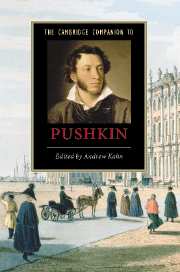Book contents
- Frontmatter
- Introduction
- Part I Texts and Contexts
- 1 Pushkin’s life
- 2 Pushkin’s lyric identities
- 3 Evgenii Onegin
- 4 Pushkin’s drama
- 5 Pushkin’s long poems and the epic impulse
- 6 Prose fiction
- 7 Pushkin and politics
- 8 Pushkin and history
- 9 Pushkin and the art of the letter
- 10 Pushkin and literary criticism
- Part II The Pushkinian tradition
- Appendix on verse-forms
- Guide to further reading
- Index
7 - Pushkin and politics
from Part I - Texts and Contexts
Published online by Cambridge University Press: 28 March 2007
- Frontmatter
- Introduction
- Part I Texts and Contexts
- 1 Pushkin’s life
- 2 Pushkin’s lyric identities
- 3 Evgenii Onegin
- 4 Pushkin’s drama
- 5 Pushkin’s long poems and the epic impulse
- 6 Prose fiction
- 7 Pushkin and politics
- 8 Pushkin and history
- 9 Pushkin and the art of the letter
- 10 Pushkin and literary criticism
- Part II The Pushkinian tradition
- Appendix on verse-forms
- Guide to further reading
- Index
Summary
Pushkin was never political in the narrow sense of the word. He never occupied an influential governmental post, and penned no significant political treatises. Yet from the 1810s to the present day the most diverse sociopolitical groups have declared Pushkin their ally. He has been variously a conservative, a liberal, a gentleman revolutionary, an ideologue of peasant revolution and a stylised Orthodox monarchist. The reasons why such diverse factions strive to make Pushkin their own lie in his long-standing and unique symbolic significance in Russian culture. The most important task facing researchers today is to free the image of Pushkin as a political poet and thinker from this accumulation of later, often tendentious, stylisations.
St Petersburg: awaiting reforms
St Petersburg: awaiting reforms: Pushkin’s political views were formed in the liberal period of the reign of Alexander I. Taught by Alexander Kunitsyn, one of the most brilliant political writers in the liberal camp, Pushkin acquired at the Lycée his first ideas about the contractual nature of power, and generally about liberalism in the spirit of Charles Montesquieu, the eighteenth-century French political theorist whose work on constitutions set out a contractual relationship between absolute rulers and subjects. In Russia, the years 1817 to 1820 saw, however, a turning away from reform.
- Type
- Chapter
- Information
- The Cambridge Companion to Pushkin , pp. 105 - 117Publisher: Cambridge University PressPrint publication year: 2006
- 1
- Cited by

